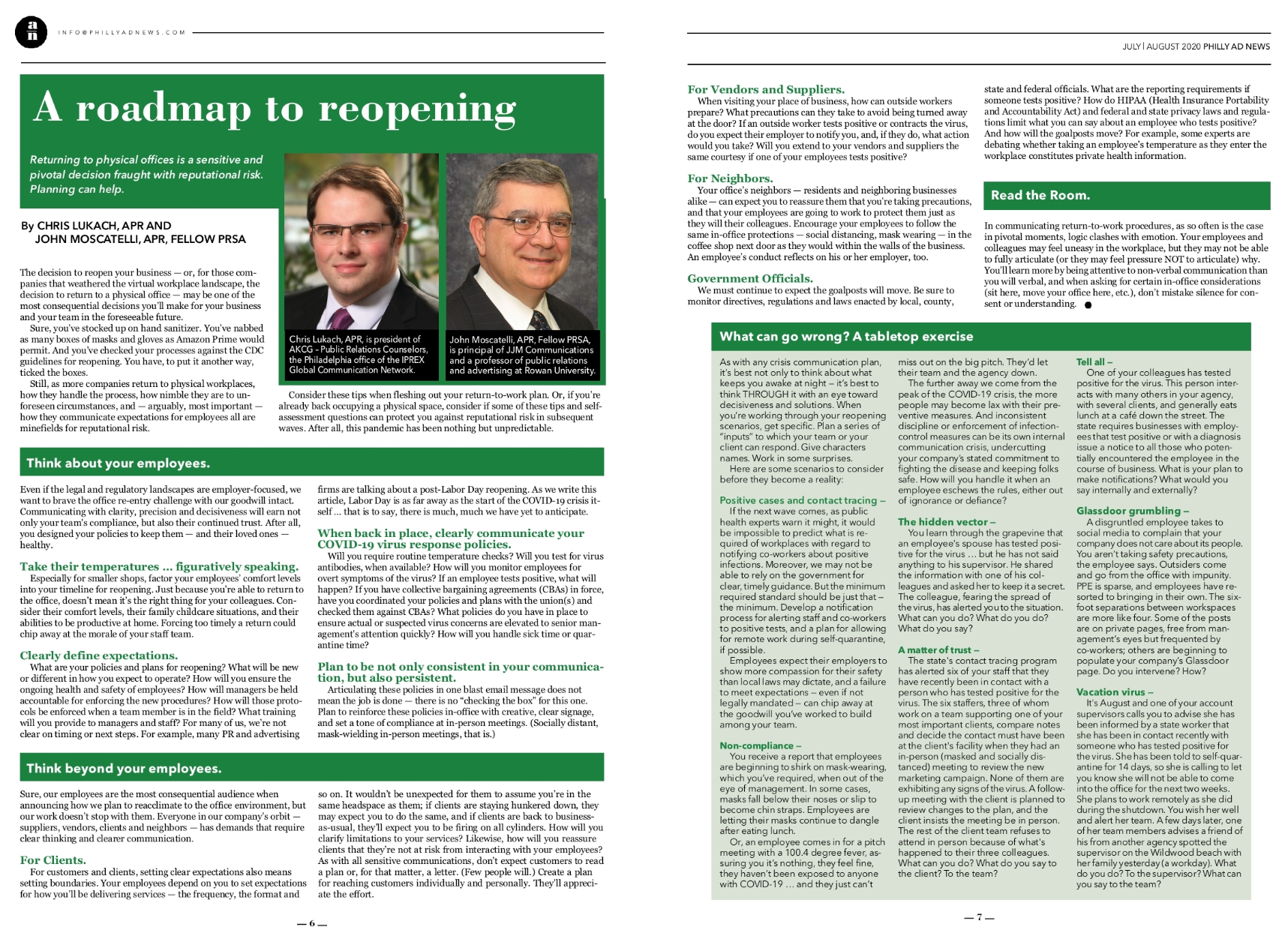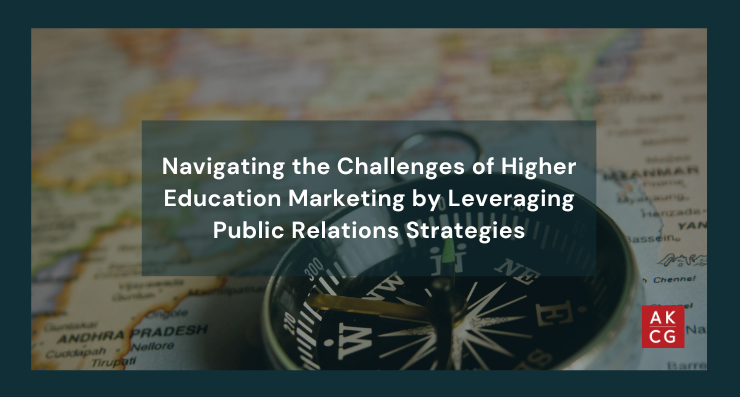In the latest edition of Philly Ad News, AKCG President Chris Lukach, APR and John Moscatelli, APR, Fellow PRSA provide a roadmap to reopening. Returning to physical offices is a sensitive and pivotal decision fraught with reputational risk. Planning can help.
By Chris Lukach, APR, and John Moscatelli, APR, Fellow PRSA
The decision to reopen your business — or, for those companiesthat weathered the virtual workplace landscape, the decision to return to a physical office — may be one of the most consequential decisions you’ll make for your business and your team in the foreseeable future.
Sure, you’ve stocked up on hand sanitizer. You’ve nabbed as many boxes of masks and gloves as Amazon Prime would permit. And you’ve checked your processes against the CDC guidelines for reopening. You have, to put it another way, ticked the boxes.
Still, as more companies return to physical workplaces, how they handle the process, how nimble they are to unforeseen circumstances, and — arguably, most important — how they communicate expectations for employees all are minefields for reputational risk.
Consider these tips when fleshing out your return-to-work plan. Or, if you’re already back occupying a physical space, consider if some of these tips and self-assessment questions can protect you against reputational risk in subsequent waves. After all, this pandemic has been nothing but unpredictable.
Think about your employees. Even if the legal and regulatory landscapes are employer-focused, we want to brave the office re-entry challenge with our goodwill intact. Communicating with clarity, precision and decisiveness will earn not only your team’s compliance, but also their continued trust. After all, you designed your policies to keep them — and their loved ones — healthy.
Take their temperatures … figuratively speaking. Especially for smaller shops, factor your employees’ comfort levels into your timeline for reopening. Just because you’re able to return to the office, doesn’t mean it’s the right thing for your colleagues. Consider their comfort levels, their family childcare situations, and their abilities to be productive at home. Forcing too timely a return could chip away at the morale of your staff team.
Clearly define expectations. What are your policies and plans for reopening? What will be new or different in how you expect to operate? How will you ensure the ongoing health and safety of employees? How will managers be held accountable for enforcing the new procedures? How will those protocols be enforced when a team member is in the field? What training will you provide to managers and staff? For many of us, we’re not clear on timing or next steps. For example, many PR and advertising firms are talking about a post-Labor Day reopening. As we write this article, Labor Day is as far away as the start of the COVID-19 crisis itself … that is to say, there is much, much we have yet to anticipate.
When back in place, clearly communicate your COVID-19 virus response policies. Will you require routine temperature checks? Will you test for virus antibodies, when available? How will you monitor employees for overt symptoms of the virus? If an employee tests positive, what will happen? If you have collective bargaining agreements (CBAs) in force, have you coordinated your policies and plans with the union(s) and checked them against CBAs? What policies do you have in place to ensure actual or suspected virus concerns are elevated to senior management’s attention quickly? How will you handle sick time or quarantine time?
Plan to be not only consistent in your communication, but also persistent. Articulating these policies in one blast email message does not mean the job is done — there is no “checking the box” for this one. Plan to reinforce these policies in-office with creative, clear signage, and set a tone of compliance at in-person meetings. (Socially distant, mask-wielding in-person meetings, that is.)
“Read the room. In communicating return-to-work procedures, as so often is the case in pivotal moments, logic clashes with emotion. Your employees and colleagues may feel uneasy in the workplace, but they may not be able to fully articulate (or they may feel pressure NOT to articulate) why.”
Think beyond your employees. Sure, our employees are the most consequential audience when announcing how we plan to reacclimate to the office environment, but our work doesn’t stop with them. Everyone in our company’s orbit — suppliers, vendors, clients and neighbors — has demands that require clear thinking and clearer communication.
For Clients. For customers and clients, setting clear expectations also means setting boundaries. Your employees depend on you to set expectations for how you’ll be delivering services — the frequency, the format and so on. It wouldn’t be unexpected for them to assume you’re in the same headspace as them; if clients are staying hunkered down, they may expect you to do the same, and if clients are back to business-as-usual, they’ll expect you to be firing on all cylinders. How will you clarify limitations to your services? Likewise, how will you reassure clients that they’re not at risk from interacting with your employees? As with all sensitive communications, don’t expect customers to read a plan or, for that matter, a letter. (Few people will.) Create a plan for reaching customers individually and personally. They’ll appreciate the effort.
For Vendors and Suppliers. When visiting your place of business, how can outside workers prepare? What precautions can they take to avoid being turned away at the door? If an outside worker tests positive or contracts the virus, do you expect their employer to notify you, and, if they do, what action would you take? Will you extend to your vendors and suppliers the same courtesy if one of your employees tests positive?
For Neighbors. Your office’s neighbors — residents and neighboring businesses alike — can expect you to reassure them that you’re taking precautions, and that your employees are going to work to protect them just as they will their colleagues. Encourage your employees to follow the same in-office protections — social distancing, mask wearing — in the coffee shop next door as they would within the walls of the business. An employee’s conduct reflects on his or her employer, too.
Government Officials. We must continue to expect the goalposts will move. Be sure to monitor directives, regulations and laws enacted by local, county, state and federal officials. What are the reporting requirements if someone tests positive? How do HIPAA (Health Insurance Portability and Accountability Act) and federal and state privacy laws and regulations limit what you can say about an employee who tests positive? And how will the goalposts move? For example, some experts are debating whether taking an employee’s temperature as they enter the workplace constitutes private health information.
Read the Room. In communicating return-to-work procedures, as so often is the case in pivotal moments, logic clashes with emotion. Your employees and colleagues may feel uneasy in the workplace, but they may not be able to fully articulate (or they may feel pressure NOT to articulate) why. You’ll learn more by being attentive to non-verbal communication than you will verbal, and when asking for certain in-office considerations (sit here, move your office here, etc.), don’t mistake silence for consent or understanding.
Click here to view the full publication.




